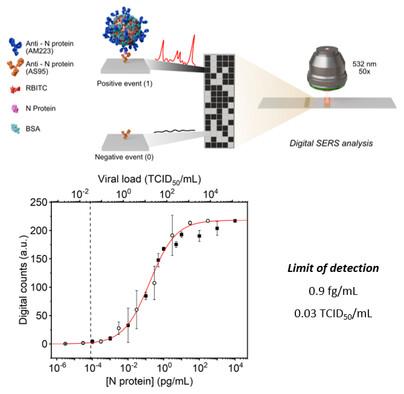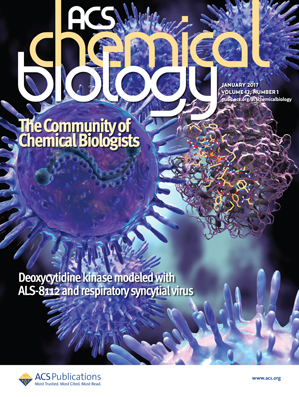利用数字 SERS 技术突破侧流免疫测定的极限,实现对 SARS-CoV-2 病毒的超低检测
IF 3.8
2区 生物学
Q2 BIOCHEMISTRY & MOLECULAR BIOLOGY
引用次数: 0
摘要
侧流免疫分析(LFIA)是一种易于使用的抗原检测方法,可提供不同的信号读数,其中最常用的是比色读数。然而,这些分析设备的灵敏度相对较低,只能产生半定量结果,限制了它们在诊断方面的应用。在本文中,我们通过实施基于数字表面增强拉曼光谱(SERS)的 LFIA 来准确、超灵敏地定量检测 SARS-CoV-2 核头壳(N)蛋白,从而解决了这些难题。与平均 SERS 强度测量相比,数字方法可以克服拉曼散射信号的波动,从而提高检测的分析灵敏度。我们的方法对鼻拭子中病毒蛋白的定量范围为 0.001 至 10 pg mL-1,检测限低至 1.9 aM(0.9 fg mL-1),比比色法 LFIA 和传统的基于 SERS 的 LFIA 提高了几个数量级。重要的是,这种方法的分析灵敏度为 0.03 TCID50 mL-1,高于其他免疫测定方法的灵敏度。总之,我们成功证明了鼻拭子中超低浓度 SARS-CoV-2N 蛋白的稳健检测和定量。数字 SERS 提高了 LFIA 的灵敏度,这为将该技术应用于诊断领域的微生物和疾病生物标志物的超灵敏检测铺平了道路。本文章由计算机程序翻译,如有差异,请以英文原文为准。

Pushing the Limits of Lateral Flow Immunoassay by Digital SERS for the Ultralow Detection of SARS‐CoV‐2 Virus
Lateral flow immunoassays (LFIAs) are easy‐to‐use antigen tests that provide different signal readouts, with colorimetric readouts being the most commonly used. However, these analytical devices have relatively low sensitivity and produce semiquantitative results, limiting their diagnostic applications. Herein, we address these challenges by implementing a digital surface‐enhanced Raman spectroscopy (SERS)‐based LFIA for the accurate and ultrasensitive quantitative detection of SARS‐CoV‐2 nucleocapsid (N) protein. Compared with average SERS intensity measurements, the digital approach allowed to overcome fluctuations in Raman scattering signals, thereby increasing the analytical sensitivity of the assay. Our method exhibited a quantification range of the viral protein in nasal swabs from 0.001 to 10 pg mL−1, and a limit of detection down to 1.9 aM (0.9 fg mL−1), improving colorimetric LFIAs and conventional‐SERS‐based LFIAs by several orders of magnitude. Importantly, this approach shows an analytical sensitivity of 0.03 TCID50 mL−1, which is greater than that reported by other immunoassays. In conclusion, we successfully demonstrate the robust detection and quantification of SARS‐CoV‐2N protein in nasal swabs at ultralow concentrations. The improvement in the sensitivity of LFIA by digital SERS may pave the way to translate this technology into the diagnostic arena for the ultrasensitive detection of microbes and disease biomarkers.
求助全文
通过发布文献求助,成功后即可免费获取论文全文。
去求助
来源期刊

ACS Chemical Biology
生物-生化与分子生物学
CiteScore
7.50
自引率
5.00%
发文量
353
审稿时长
3.3 months
期刊介绍:
ACS Chemical Biology provides an international forum for the rapid communication of research that broadly embraces the interface between chemistry and biology.
The journal also serves as a forum to facilitate the communication between biologists and chemists that will translate into new research opportunities and discoveries. Results will be published in which molecular reasoning has been used to probe questions through in vitro investigations, cell biological methods, or organismic studies.
We welcome mechanistic studies on proteins, nucleic acids, sugars, lipids, and nonbiological polymers. The journal serves a large scientific community, exploring cellular function from both chemical and biological perspectives. It is understood that submitted work is based upon original results and has not been published previously.
 求助内容:
求助内容: 应助结果提醒方式:
应助结果提醒方式:


